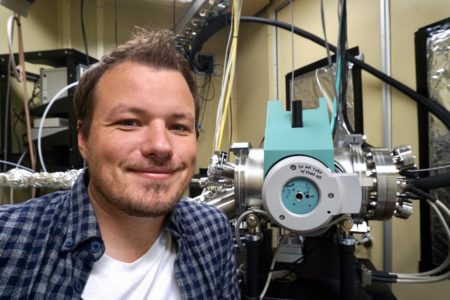 Bjoern Enders joined the ALS as a postdoc in July 2016. He first worked on Beamline 5.3.2.1 before moving to Beamline 7.0.1 (COSMIC) when 5.3.2.1 was disassembled and the ptychography program was moved in the summer of 2017. His research is part of the NSF Science and Technology Center STROBE.
Bjoern Enders joined the ALS as a postdoc in July 2016. He first worked on Beamline 5.3.2.1 before moving to Beamline 7.0.1 (COSMIC) when 5.3.2.1 was disassembled and the ptychography program was moved in the summer of 2017. His research is part of the NSF Science and Technology Center STROBE.
What brought you to the ALS?
When I was doing my ERASMUS exchange year in Sweden, there was a publication on single-shot coherent diffraction imaging. The target was destroyed, but they collected one diffraction pattern. They used an algorithm that iterated between the Fourier plane and the real plane to figure out the structure. As a student, I thought this was cool. So, I worked on a similar technique at the Institute for X-Ray Physics at Göttingen back in Germany, and afterward I transferred to ptychography when I went to the Technical University of Munich for my PhD.
Ptychography is coherent diffraction microscopy, so you don’t collect a direct image of your specimen. Instead, you let the beam hit the sample and collect the diffracted wave from many overlapping positions as you are scanning the sample. A ptychography algorithm then uses the overlapping positions and the diffraction data to figure out the object transmission function. As there is no direct formula to retrieve the sample, such algorithms operate iteratively to narrow the solution space and find the right result. Writing my own software PtyPy for reconstruction helped me get some job offers, and then I got an email from David Shapiro about a postdoctoral position, and I thought, “California is nice!”
What is the focus of your research here?
One of our biggest projects is called streaming ptychography. Conventionally, there were three distinct steps—data acquisition, purification or pre-processing, and reconstruction. The redesign to streaming ptychography does everything at the same time, so you can pre-process and reconstruct the data as it comes in. It’s a collaboration with Stefano Marchesini at CAMERA (the Center for Advanced Mathematics for Energy Research Applications), the detector group, and the IT group. It might not have been my scientific mission before, but it became my scientific mission.
When I came here, I switched a bit from ptychography to data analysis and data preparation because my project required very good diffraction data, but the existing pipeline that was assembling and pre-processing the diffraction frames from the data stream of the charge-coupled device (CCD) wasn’t producing the data quality I wanted.
I started meddling with it and eventually replaced all the components with my own code, which was a super interesting project. Turns out, redesigning the pipeline is one of the crucial components to make streaming ptychograpy happen. Now the beamline runs my data-processing pipeline.
I am also working on extending the data workflow to NERSC to tap into their computing and hosting resources. For example, I’ve made a small web app as a searchable catalog for ptychographic data hosted at NERSC, and I think other people are using it, but it’s not finished.
I really enjoy developing the software at a synchrotron. Of course, if you write software for a production beamline, you need to make it stable. So far, it runs fine.
Where do you see this field going?
Data management is an underdeveloped field at the ALS. For everything that comes after the last optical element, each beamline is on its own when it comes to handling and managing the data. It’s a huge jungle out there, especially if you think about ALS-U and the high data rate, people will want to integrate with NERSC and use centrally maintained tools. COSMIC is a flagship beamline for ALS-U, and it has a high data rate, so solutions found for COSMIC might serve as a model or at least as a pool of ideas. There is a new ALS Computing Group for tackling these problems, so this field is interesting for the Lab.
Is that a space that interests you?
I like it—it has interesting challenges! I think this is more of a management field, but the relevance for ALS on hands-on problems give it a very appealing scientific touch.
What is life like as a postdoc?
When I started, I felt pretty isolated. That might be common for new postdocs, but then I joined the Berkeley Lab Postdoc Association as a board member, and I started organizing hikes, pub nights, and now I am also the treasurer. The BLPA does a lot of unpaid work to make the lives of postdocs better. This is a great group from all over the world. We regularly organize a welcome for new postdocs, a monthly meet & greet, pub nights, speaker series, and much more. The hikes are very popular. We went to Point Reyes, Stinson Beach, parks in the mountains, Angel Island, and even some waterfalls in the north. All early-career people are welcome to join.
Socially, I feel well connected now. Scientifically, I’d like to see a mailing list for people to email about research questions, needing access to equipment, or offering collaborations. People can help each other out.
What do you do in your free time?
I don’t have that much free time, but I like to travel. I go jogging occasionally, and I play tennis, though I’m not very good. I should say I let tennis play with me.